
Goats in the Sailor's Diet: 1 2 3 4 Next>>
Goats in Sailor's Diets During the Golden Age of Piracy, Page 3
Goats as Food: South China Sea
"China is one of the plentifullest Countries in the World for Provisions, they are all cheap, and as good as the best in Europe. There is great abundance of Beef, Pork all the Year about, Mutton, Goats-Flesh, hens, Capons, Geese, Pheasants, tame and wild Ducks, Pigeons, Turtle-Doves, small Birds, and all very good; there is no want of Horse-flesh: Dogs-Flesh is look’d upon as a dainty". (Domingo Navarrete, The Travels and Controversies of Friar Domingo Navarrete 1618-1686, p. 150)
The South China Sea might seem like another odd location for pirates. True, the area has been a hotbed of piracy on and off throughout history, particularly in the early 19th century, but during the
golden age of piracy, the European pirates generally focused their attention in the Atlantic and Indian oceans. Still, adventurers and privateers made their way to the South China Sea. With his usual studious eye, William Dampier provided a great deal of information about some of the islands in the South China Sea during his travels in 1687, with goats playing a role.
Dampier tells his readers that the island of St. Johns [Shangchuan] provides "China-Hogs, Goats, Buffaloes, and some Bullocks." While the goats only merit that mention, Dampier is fascinated by the hogs, possibly Beijing Blacks, explaining that they "are all black; they have but small Heads, very short thick Necks, great Bellies, commonly touching the Ground and short Legs. They eat but little Food, yet they are most of them very fat; probably because they Sleep much."1
While in the 'Piscadores' [Penghu], Dampier's ship received a gift of food from the governor of a city [probably Magong] which included "a young Heifer, the fattest and kindliest Beef, that I did ever taste in any foreign Country; 'twas small, yet full grown; two large Hogs, four Goats, two Baskets of fine Flour, 20 great flat Cakes of fine well-tasted Bread, two great Jars of Arack (made of Rice as I judged) called by the Chinese, Sam Shu [samshu is indeed a Chinese liquor distilled from rice]; and 55 Jars of Hoc Shu [probably some kind of malt liquor], as they call it, and our Europeans from them."2
Goats as Food: South China Sea - Bashi Islands
During his journey in the South China Sea, Dampier tells us that his men named a large island north of the Philippines 'Bashee' or 'Batans'.3 This was eventually modified into Bashi and Batanes. Dampier and his crew spent almost 3 months there. Of the islands they visited, "the smallest of all, we called Goat Island [modern Dequey Island],
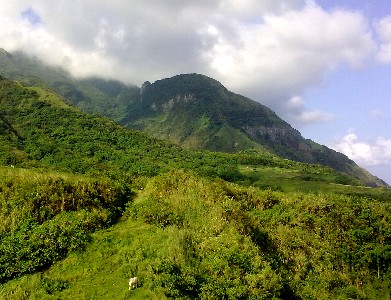
Photographer: Ardie Davocol
Grazing on Mt. Iraya in the Batanes (Philippines)
from the great number of Goats there... but Goat Island is all flat and very even."4
They named another island they visited Orange [modern Itbayat], which the visited "to see their manner of living, and what Provision they had"5. Staying off-shore, Dampier explains,
the Natives brought aboard both Hogs and Goats to us in their own Boats; and every Day we should have fifteen or twenty Hogs and Goats in Boats aboard by our side. These we bought for a small matter; we could buy a good fat Goat for an old Iron Hoop, and a Hog of seventy or eighty Pound weight for two or three Pound of Iron. ...It was one Man’s Work to be all Day cutting out Bars of Iron into small Pieces with a cold Chisel: And these were for the great Purchases of Hogs and Goats... Every Morning, as soon as it was light, they would thus come aboard with their Commodities; which we bought as we had occasion. We did commonly furnish our selves with as many Goats and Roots as served us all the Day...6
Ever looking for interesting details and the personal observational touch, Dampier explained how the men would
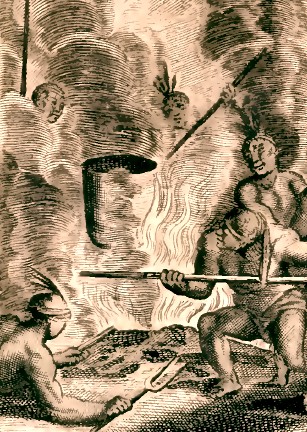
Artist: Arnoldus Montanus (1671)
Cooking, From De Nieuwe en
Onbekende Weereld
throw the left-over goat stomachs and skins in the water after they had eaten the meat, which the natives of the islands would rescue.7 With the goat's skins, Dampier explained that the natives "would carry ashore, and making a Fire they would singe off all the Hair, and afterwards let the Skin lie and parch on the Coals, till they thought it eatable; and then they would knaw it, and tear it in pieces with their Teeth and at last swallow it."8
The stomachs [paunches] were used to "make them an excellent Dish"9. Dampier gives a rather thorough description of this complex meal's preparation:
They would turn out all the chopt Grass and Crudities found in the Maw into their Pots and set it over the Fire, and stir it about often: This would smoak and puff, and heave up as it was boiling; Wind breaking out of the Ferment and making a very savoury Stink. While this was doing, if they had any Fish, as commonly they had two or three small Fish, these they would make very clean (as hating Nastiness belike) and cut the Flesh from the Bone, and then mince the Flesh as small as they possibly could, and when that in the Pot was well boiled, they would take it up, and strewing a little Dung in the Maw would look like so much boiled Herbs minc'd very small10
Dampier sampled it, noting that "my Stomach would not take [it]."9
1 William Dampier, Memoirs of a Buccaneer, Dampier’s New Voyage Round the World -1697-, p. 275; 2 Dampier, p. 284; 3 Dampier, p. 285; 4 Dampier, ibid.; 5 Dampier, p. 294; 6 Ibid.; 7 Dampier, p. 290; 8 Ibid.; 9 Ibid.; 10 Dampier, p. 290-1; 11 Dampier, p. 291
Goats as Food: South America
"The Market [in Pernambuco, Brazil] is stocked well enough, Beef being at five Farthings per l. a Sheep or Goat at nine Shillings, a Turkey four Shillings, and
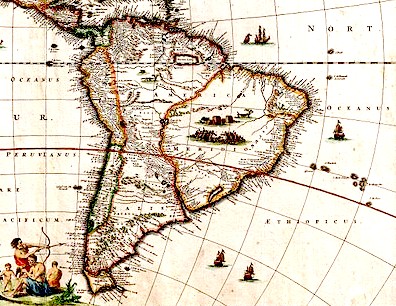
Visscher Map of South America (1658)
Fowls two Shillings, the largest I ever saw, and may be procured much Cheaper, by hiring a Man to fetch them out of the Country." (Captain Charles Johnson, A general history of the pirates, 3rd Edition, p. 214)
South America could be a tricky place for European sailors, pirates or not. Much of it was the property of the Spanish and they didn't look kindly on foreign interlopers. However, just as the Portuguese had left goats to proliferate and provide future food stock for travelers on Madagascar, so the Spaniards had left goats in convenient places along the South American coast.
In 1680, buccaneer Bartholomew Sharp revealed that on the Isle of Plate [probably near Guayaquil, Ecuador] "we went ashoar and found great plenty of Goats, which we drove together and caught some alive, but others we killed and salted, and found them very refreshing to us"1. Spaniards notwithstanding, sailors had to eat, and if they could get fresh meat when making landfall which their enemy had left behind, so much the better.
Goats as Food: South America - Ascension Island and St. Helena
In all fairness, Ascension Island and St. Helena could really be said to be a part of the African
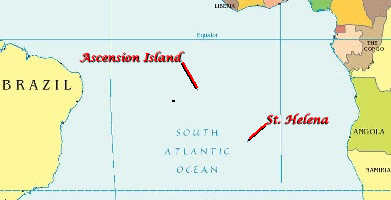
The Locations of Ascension Island and St. Helena, Map: CIA Factbook
Coast as much the South American, because they're as near to being in the middle of the two continents as you could want. Wikipedia tells us that Ascension Island was "dry and barren [with] little appeal for passing ships except for collecting fresh meat" which included sea turtles and birds.2 St. Helena, on the other hand contained "an abundance of trees and fresh water."3 During their exploratory voyages in the 14 century, the Portuguese decided they would make convenient supply points for passing ships and placed goats on both of these islands. St Helena was so accommodating that "sick mariners were left on the island to recover, before taking passage on the next ship to call on the island."4
Captain Francis Rogers stopped at Ascension Island in 1703 where he
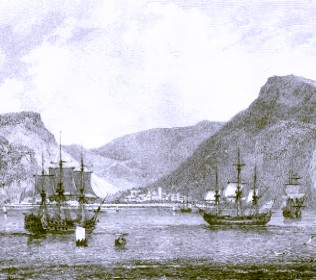
St. James Port, St. Helena Island (1813)
found "some wild goats".5 Other period voyages made landfall here, although they didn't mention the goats in particular. In fact, William Dampier stopped on Ascension Island for a bit of an extended stay which we'll discuss in more detail shortly.
Captain Rogers also mentioned St. Helena during the same voyage, revealing that there is "a pretty deal of black cattle here which are small, with hogs, poultry and multitudes of goats, which run among the steep rocks, sure-footed as a catt."6 Seaman Edward Barlow also made landfall on St. Helena, describing it as having "some wild fowl upon it, as guinea hens and partridges; and now it is plentiful in all manner of provisions, as excellent good beef, and hogs and goats and hens, but bread corn they have none, for they cannot sow any by reason of the roughness of the ground."7 The lesson here is that if you want to make Edward Barlow happy, goats are good, but you really need to have some bread corn on hand.
Goats as Food: South America - Juan Fernandez Islands
There is probably no goat-infested island more storied in golden age of piracy era literature than the Juan Fernandez Islands. There are actually four of them, but period sources seem to be primarily
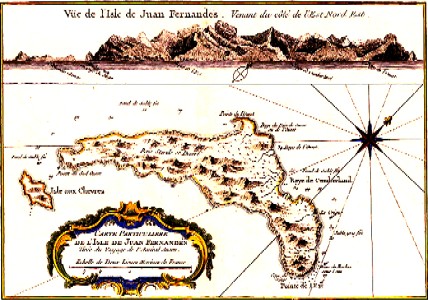
Juan Fernandez Island Map by Jacques Nicolas Bellin (1753)
referring to the island that is today named Robinson Crusoe Island or Isla Más a Tierra. As mentioned previously, goats were introduced to this normally uninhabited, careen-friendly island by the Spanish. Knowing a good thing when they saw it, European ships would frequently stop at this convenient piece of land on their way around South America.
On Christmas Day, 1680, Buccaneer captain Sharp stopped on the eastern-most island and "found it a very refreshing Place to us both in respect to the Goats we found here, whereof we salted about an hundred, and took as many on board alive, as to the fresh Water wherewith we filled our Vessels."8
Four years later, William Cowley likewise availed his ship and crew of "the Island of Juan Fernandes... where we found plenty of excellent fat Goats, good Fish, and abundance of very good Timber, with incomparable good Water. Here is such great plenty of Fish, that one Man may catch enough in a Days time to suffice 200 Men."9 Captain William Funnell remarked in 1704 that from the goats on Juan Fernandez "we used to get store; and a Joint of one of them roasted, with about half a foot of our Cabbage boiled, makes a very good Meal."10
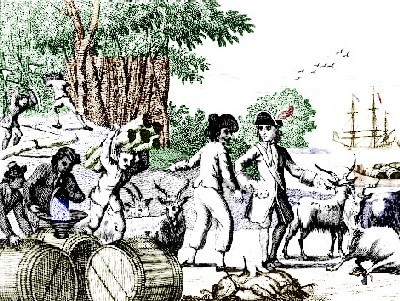
Taking in Provisions on Juan Fernandez Island,
From
An Historical Account of All the Voyages Round the World Performed by
English Navigators, Volume I (1774)
Perhaps the most famous stop was that made during Woodes Rogers' privateering voyage in 1709. It was here that they found castaway Alexander Selkirk, for whom another of the Juan Fernandez Islands was eventually renamed.
While the tale of Selkirk is fascinating, it overshadows the basic fact that the crews of Rogers' little fleet had really stopped for another reason entirely. Edward Cooke, captain of the second ship, the Dutchess, explained their real purpose in stopping. "Things [were] in a Readiness for careening our Ship, [so we] started some of our Salt Water Cask that had been fill’d at Sea, unbent our Sails, and made a Tent on the Shore for our Doctor and sick Men; caught abundance of fresh Fish, got Cabbage and Goats"11. While on the island, the men "saw many pleasant Streams of fresh Water running down from the Mountain to the Sea, and on those Hills great Numbers of Goats, and other wild Beasts... They found Plenty enough of Goats, and other such Creatures; but could take none, by Reason of the Woods."12
1 Bartholomew Sharp, "Captain Sharp's Journal of His Expedition," from William Hacke's A collection of original voyages, p. 38; 2 Ascencion Island, wikipedia, gathered 4/6/13; 3 St. Helena, wikipedia, gathered 4/6/13; 4 Ibid.; 5 Francis Rogers. from Bruce S. Ingram's book Three Sea Journals of stuart times, 1936, p. 193; 6 Rogers. p. 191; 7 Edward Barlow, Barlow’s Journal of his Life at Sea in King’s Ships, East and West Indiamen & Other Merchantman From 1659 to 1703, p. 199; 8 Sharp, p. 44; 9 William Ambroise Cowley, "Crowley’s Voyage Round the Globe" from William Hacke’s book A collection of original voyages, p. 7; 10 William Funnell, A Voyage Round the World, p. 20; 11 Edward Cooke, A Voyage to the South Sea and Round the World in the Years 1708 to 1711, p. 35; 11 Cooke, p. 100-1

